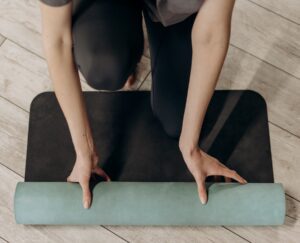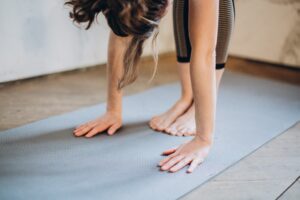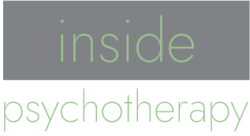Finding peace in a forward fold
As a professional performing artist for over 10 years in musical theater, I adored the process of making a show. The rehearsal process meant learning and honing new music and choreography, drilling it to as close to perfection as possible, and of course making new friends and acquiring new skills.
But nothing compared to the moment the curtain went up and there was an audience. My kicks were higher, smile broader, adrenaline was coursing through my body and my voice felt more expansive than ever. All those hours in class and in rehearsals paid off big time.
So it was quite a shock for me to take my first yoga class, and truth be told, I didn’t appreciate it much.
Where were the mirrors? How would I know if I was doing the poses right? Without my body to look at, and my voice to listen to, how would I know my place in this practice?

How would I recognize myself?
As a dancer, I thought I would nail the postures at first try. I would only later learn that I had it all wrong.
To say that I was humbled is an understatement. Initially, I used yoga as another place to critique my actions. There was one pose in particular that I especially dreaded but found to be a part of every class I took no matter who the teacher was. And not surprisingly (in hindsight of course), this pose became the doorway for me through which I began to understand what this practice can be.
Uttanasana, or standing forward bend, became one of my greatest teachers.
Uttanasana, literally translated as “intense stretch pose” (and so true), seemed easy for me in the dance world. Just stand up and then bend forward and touch your toes—easy. In yoga, I have learned that Uttanasana requires a vast amount of internal honesty to practice not only safely but meaningfully.
By honesty, I mean that yoga doesn’t care if you can touch your toes or how far forward you bend.

It has more to do with the thought put into the pose, rather than attaining a goal.
Some of the many benefits of Uttanasana are:
- Relieving stress and “resetting” the brain
- Opening the back of the legs and strengthening the thighs and knees
- Reducing fatigue and anxiety
- Relieving headaches, insomnia and symptoms of menopause
- Improving digestion
Uttanasana: Standing forward bend (intense stretch pose)
- Stand with the feet hip width apart (for very tight hamstrings, a little wider), lift the toes and engage the leg muscles.
- On an inhale, raise your arms overheard and elongate your spine and lengthen your torso.
- On an exhale, bend forward keeping the spine straight and long, releasing your arms down toward the floor.
- If you feel intense tightness in the backs of your legs bend your knees or bring the floor up to you by placing your hands on blocks or stacks of books.
- With each inhale lift and lengthen the front of your torso just a little, and with each exhale release a little more into the bend.
- To come out of the pose, on an inhale press your feet into the floor and drop your tailbone as your rise up bringing your hands overhead.
- Exhale as your bring your arms down to your sides to the starting position.
* Those with low back problems should not practice Uttanasana without an experienced yoga teacher.
Yes, there is anatomy involved in Uttanasana—talk of ankles, knees and hips, among other things that may come up in a group class or private session. But there also tends to be a great deal of internal chatter, such as, “When will this be over?” “Why can’t I be more flexible?” “Why does this hurt so much?” And one I hear often, “I used to be able to do this.”
The point is, in yoga, none of that matters. What all of the chatter boils down to in Uttanasana is simple observation, “My hamstrings are tight”—that’s it.
And then you practice.
Originally published at ElephantJournal.com.



